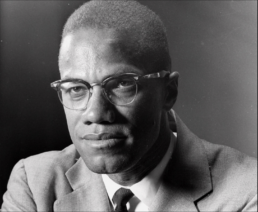These life stories may contain descriptions of childhood trauma and abuse, as well as images, voices and names of people now deceased. If you need help, you can find contact details for some relevant support services on our support page.
Celebrated African American activist, Malcolm X (1925-1965), was in foster care, a juvenile detention centre, and kinship care.
Born Malcolm Little to Louise Helen Little and Baptist minister Earl Little in Omaha, Nebraska, Malcolm X was the seventh of his father’s children (he had three by a previous marriage) and the fourth of Louise and Earl’s children.
Both Louise and Earl were followers of the Jamaica born political leader Marcus Garvey. They were also involved in the local Universal Negro Improvement Association. Their involvement put the family at risk; when Malcolm was four years old the family moved to Milwaukee, Wisconsin and then to Lansing, Michigan in response to threats from the Ku Klux Klan.
Earl was killed when Malcolm X was six. Officially recorded as a streetcar accident, Louise believed that her husband was murdered. She received a payout on one insurance policy but the other was declined on the grounds Earl’s death was a suicide.
So there we were. My mother was thirty-four years old now, with no husband, no provider or protector to take care of her eight children. But some kind of a family routine got going again. And for as long as the first insurance money lasted, we did alright (Malcolm X, 90).
As finances became tight, welfare authorities began to visit Louise. She received some financial assistance, but it took a toll on her and eventually she was confined to a mental hospital. Malcolm was placed with the Gohanna family, and he enjoyed his time there.
At age thirteen, Malcolm X was sent to a detention centre and for the most part he enjoyed his stay there too. A white woman, Mrs Swerlin, ran the home with her husband and Malcolm X recalled them being “good people“. Mrs Swerlin organised attendance at a local high school and a part-time job, all of which Malcolm X was happy with. He did well in school and went regularly back to see his siblings.
When he was fifteen, Malcolm X met up with his sister, Ella, from Earl’s first family. Malcolm X was impressed with Ella, who owned property and lived in Boston.
I think the major impact of Ella’s arrival, at least upon me, was that she was the first really proud black woman I had ever seen in my life. She was plainly proud of her very dark skin. This was unheard of among Negroes in those days, especially in Lansing (Malcolm X, 114).
Malcolm X took up Ella’s invitation to visit her during the summer holiday. The visit which made him restless back home. After he was released from the detention centre, fifteen-year-old Malcolm returned to stay with Ella in Boston.
For the next five years, Malcolm X immersed himself in hipster culture. He wore zoot suits, became friends with jazz musicians, and supported himself through a range of jobs from shoe shining to waiting tables, steering ‘johns’ to their appointments with sex workers, and dealing drugs. He was eventually incarcerated for five years for burglary.
In prison, Malcolm X gave up drugs, read voraciously, and became a Muslim and member of the Nation of Islam (NOI). He kept up a regular correspondence with founder Elijah Muhammad, and recruited for the NOI on his release from prison.
Malcolm X became a charismatic, articulate and controversial spokesman for the NOI, speaking on college campuses across the United States, and on radio and television.
In 1964, Malcolm X broke with the NOI and founded Muslim Mosque, Inc. After a pilgrimage to Mecca that year, he became a Sunni Muslim and took the name el-Hajj Malik el-Shabazz. The following year he founded the Organization of Afro-American Unity to extend the call for human rights to all oppressed peoples.
Malcolm X was assassinated on 21st February 1965.
I believe that it would be almost impossible to find anywhere in America a black man who has lived further down in the mud of human society than I have; or a black man who has been any more ignorant than I have been; or a black man who has suffered more anguish during his life than I have. But it is only after the deepest darkness that the greatest light can come; it is only after extreme grief that the greatest joy can come; it is only after slavery and prison that the sweetest appreciation of freedom can come (Malcolm X, 498).
Malcolm X is regarded by many as one of the most influential African Americans in history. His birthday is celebrated in numerous cities across the United States, and there are various streets named after him, too, as well as schools.
The Malcolm X and Dr Betty Shabazz Memorial and Education Center, a memorial to both Malcolm X and his wife, is located in Manhattan, New York City in the building where Malcolm X was assassinated. It opened on the 80th anniversary of his birth.
References:
Malcolm X. The Autobiography of Malcolm X (with Alex Hayley), Penguin, 1964/2001.
Mamiya, Lawrence. “Malcolm X. American Muslim leader.” Britannica, 2022. https://www.britannica.com/biography/Malcolm-X
“Timeline of Malcolm X’s Life.” American Experience, PBS. https://www.pbs.org/wgbh/americanexperience/features/malcolmx-timeline-malcolm-xs-life/
Image available here.
